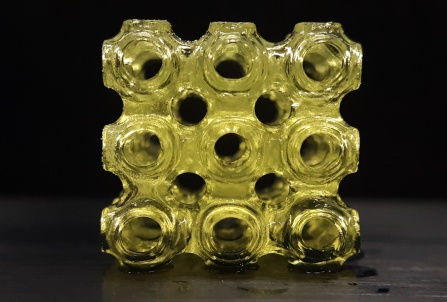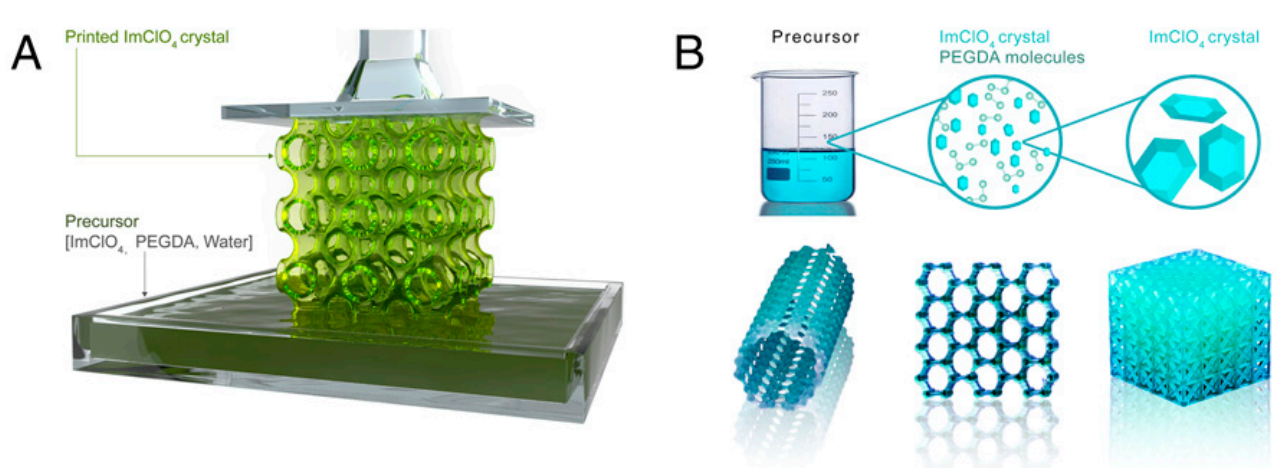A team of researchers from the University of New York at Buffalo and MIT have developed a new ferroelectric metamaterial for photopolymerization 3D printing.
The novel composite resin is reportedly a major leap toward making synthetic materials more affordable and suitable for a variety of advanced applications, such as acoustic shields, shock absorbers, and even electronics.
Shenqiang Ren, lead author of the study, states: “the sky’s the limit when it comes to ferroelectric metamaterials”.

Ferroelectric metamaterials
The ‘metamaterial’ part of the term refers to materials that have been modified to have properties that do not naturally occur outside of a lab. The ‘ferroelectric’ part relates to crystalline structures that display spontaneous electric polarization that can be reversed through the use of an electric field. According to the paper, research into such synthetic materials has been going on for years, but cost-efficiency and application adaptability have always been major hurdles.
Still, the quality of ferroelectricity in organic materials has been utilized for decades in a number of everyday goods, including computer components, RFID cards, and imaging apparatus. Therefore, the ability to 3D print custom geometries with ferroelectric materials would be a very powerful tool.
Water-soluble, self-healing, and reprogrammable
The team utilized a substance called imidazolium perchlorate (ImClO4) as the ferroelectric component of the novel material. ImClO4 is a transparent material with a reprogrammable stiffness, as well as being completely soluble in water. As such, it’s compatible with SLA 3D printing technology, whereby the material’s low refractive index allows UV and visible light to pass through with minimal scattering.
With the aim of 3D printing a scaffold-supported crystalline lattice made of ImClO4, the scientists mixed a powdered form of the material with an off-the-shelf UV resin and water in a commercial LCD 3D printer. The reprogrammable nature of the material’s stiffness – how much it resists deformation – meant that the researchers were able to tune it to filter out different subwavelength vibration frequencies. The printed part was also seen to ‘self-heal’ when cracked, and even self-corrected deviations in its geometry during the printing process.

When it came to its ferroelectric performance, the printed mixture was not too dissimilar from pure ImClO4. Its polarization shifted as expected in response to an electric field, leading Ren to believe 3D printers can indeed be used in the development of molecular ferroelectric metamaterials.
The potential of the work has also been noted by the U.S. Army Research Office (ARO), who partially funded the research. Evan Runnerstrom, Program Manager at the ARO, states: “One of the reasons ARO is funding professor Ren’s project is that molecular ferroelectrics are amenable to bottom-up processing methods – like 3D printing – that would otherwise be challenging to use with traditional ceramic ferroelectrics. This paves the way for tunable metamaterials for vibration damping or reconfigurable electronics, which could allow future Army platforms to adapt to changing conditions.”

Further details of the study can be found in the paper titled ‘A 3D-printed molecular ferroelectric metamaterial’. It is co-authored by Shenqiang Ren, Chi Zhou, Mostafa Nouh et al.
Chemical innovations in the field of resin production are commonplace in 3D printing research. A team of researchers from the University of Texas at Austin recently developed a novel photopolymer resin that makes high-resolution visible light curing significantly faster. The panchromatic ‘rapid-cure’ material is curable in four different colors of light – violet, blue, green, and red – and contains a monomer, a photoredox catalyst, two co-initiators, and an opaquing agent.
Elsewhere, 3D printer manufacturer Nanoscribe recently launched a new photopolymer resin for its two-photon lithography process. Dubbed IP-n162, the material features a high refractive index and disperses easily, making it great for microfabrication applications.
Subscribe to the 3D Printing Industry newsletter for the latest news in additive manufacturing. You can also stay connected by following us on Twitter and liking us on Facebook.
Looking for a career in additive manufacturing? Visit 3D Printing Jobs for a selection of roles in the industry.
Featured image shows a 3D printed ferroelectric lattice. Photo via University of Buffalo.



